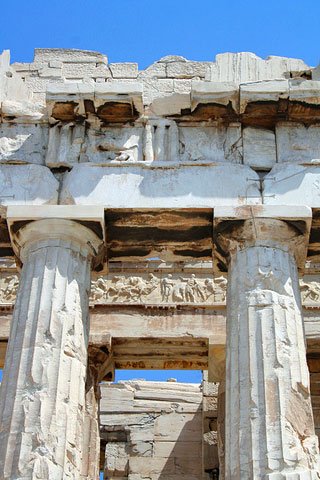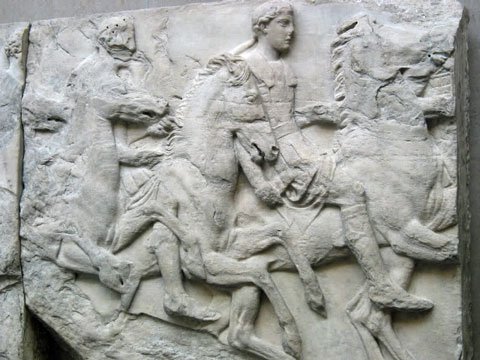The term “Elgin Marbles” must be very irritating to many Greeks today. The marble slabs are actually part of the frieze which ran around the whole of the Parthenon inside the peristyle. So they should really be known as the Parthenon frieze.
They became known as the Elgin Marbles in the early part of the 19th century after Lord Elgin, the British ambassador to Turkey – which at that time ruled Greece – had them removed and sent to Britain. The majority of them are now held in the British Museum in London.
The Parthenon Frieze
In a normal Doric temple there would be triglyphs alternating with metopes above the columns forming a geometric frieze, but nothing else behind the columns. In the Parthenon the frieze could only be seen through the columns, and looking right up. This meant they had to be very carefully crafted so the details could be seen. The frieze was composed of marble blocks next to one another. It was about 1m high (3’3″) and 160m long (524 feet), and went all around the Parthenon. It is thought that the theme was the Great Panathenaia, the procession the Athenians held in honour of Athena.
One suggestion is that it was made in honour of those who died at the battle of Marathon defending Greece against the Persians. The basis for this is that the number of men portrayed in the frieze (not counting the charioteers) come to 192, which is the number of those who died at Marathon.
There is no other building in ancient Greece which commemorates a procession, but there is in Persia. At the palace at Persepolis which was built between 500 and 460 BC they used processions to decorate their stairways. Many of the sculptors who worked at Persepolis were Greeks, and many Greek travelers visited Persia, so the Athenians would certainly have known this. It has been suggested that this was where the Athenians got their idea.

This photo shows the triglyphs (the geometric pieces with three sections) alternating with the metopes (the sculpted pieces). Then behind the columns you can see the replicated frieze in sunlight – originally it would have been in deep shadow as it would have been covered by the roof.
A different viewpoint
The marbles of the frieze known as The Elgin Marbles and displayed in the British Museum are not seen in the same way they would originally have been viewed. At the Parthenon, you had to walk around the outside of the building to see all of the frieze, whereas in the museum you can stand in the centre of the room and just turn around to see it.
In the museum you can practically stand with your nose against the marble; in the Parthenon it would have been about 10 metres above you (33’0″), so you had to crane you neck to see it. (See photo below).
Of course, it’s nice to be able to appreciate the marbles close up. But if you go to Paestum, in southern Italy, and visit the museum there, you’ll see how they have built a platform so you can see the details of a temple in a more natural way. A similar idea has been used in the new Acropolis museum.
The skill involved
You might wonder why such a fuss is made of these marble sculptures. To begin with, most of them are a very high quality of workmanship. When compared with other work in the Greek world of the same period, whoever was in charge made sure it was all made to the highest quality.
It’s thought that Phidias, who was the director of works and the sculptor of the main statue inside the Parthenon, was also in charge of the frieze.
The remarkable thing is the relief of the sculptures (the depth of the carving) is nowhere deeper than about 3 inches, yet the figures look almost three dimensional.
Not only is the craftsmanship of a high order, but the figures have a freedom and joy of life seldom seen in carvings. The movement is remarkable, from the gentle ease of the maidens to the strength and vitality of the horses.
The new Acropolis Museum has reproductions on display in a space reserved for the originals.

So who should have the Elgin Marbles?
The controversy over the Elgin Marbles started from about 1801. Turkey ruled Greece, and Britain had recently improved relations with Turkey. Lord Elgin received a letter of authorization from the Grand Vizier (no less!) that he could basically do what he wanted. Part of the document reads:
“…and that when they wish to take away any pieces of stone with old inscriptions or figures thereon, that no opposition be made thereto.”
Many travelers of the time were appalled by what was taking place. A French visitor wrote:
“It is a sad thing to remark that the civilized peoples of Europe have caused more harm to the monuments of Athens in the space of 150 years than all the barbarians together over a period of several centuries. It is hard to think that Alaric and Mahomet II respected the Parthenon, yet it has been overturned by Morosini and Lord Elgin.”
Elgin was unable to keep the sculptures for himself, as he ran out of money, and had to sell them to the British Museum.
Those defending the status quo say that it was entirely legal, and the marbles would only have been burnt to produce lime. (There is some truth to this, as it happened to other remains.)
Those against say Turkey had no right to rule Greece in the first place, so any claimed legalities don’t count. They also say treasures like the Elgin Marbles should be returned to their original sites.
The response is that even in countries like Greece and Egypt, treasures are not left in situ. For example, many of the Minoan treasures from Crete are in the Museum at Athens, and the museum in Cairo is full of stuff from other parts of the country which isn’t even seen by the public.
The counter claim is that at least these items are in their country of origin. And on it goes…
Treasures of history
One thing is sure. If the Elgin Marbles were ever returned to Greece, it would set a precedent which would rock the great museums of the world. The Louvre in Paris, the Metropolitan Museum in New York, the British Museum in London, and many others – all their prized possessions would be under threat.
Let’s hope that whatever the powers that be decide in these matters, that you and I will still be able to view these treasures of history, and marvel at the skill and dedication of the ancient civilizations which have preceded us.